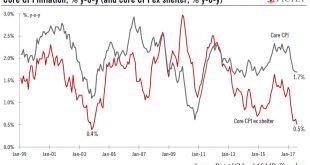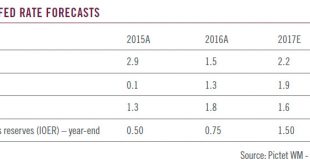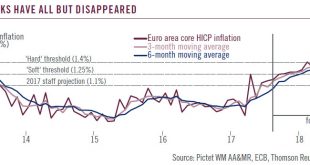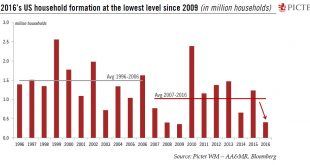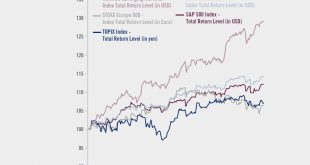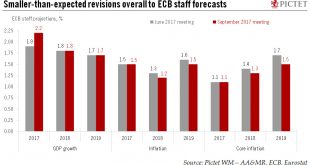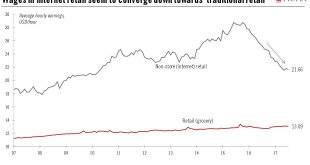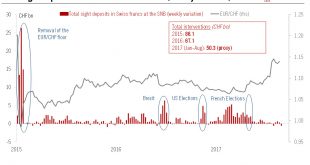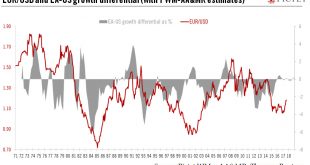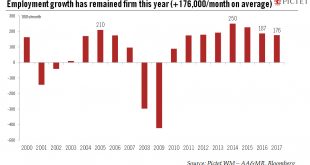The inflation rate remains tepid, but we still think there is a greater probability that the Fed hikes rates in December than the market is currently pricing.CPI inflation was 0.4% m-o-m, boosted by gasoline prices, pushing the y-o-y print to a still-tepid 1.9%. Core CPI inflation was up 0.25% m-o-m; the y-o-y reading was stable at 1.7%.While improving from recent lows, there is no sign of a ‘regime shift’ in US inflation, despite the tight labour market. Globalisation and technology...
Read More »Hopes of US fiscal easing are evaporating
In spite of disappointment on the fiscal policy front and even though we expect a slowdown in growth next year, the US economy remains in fine fettle.Chaotic developments in the White House and ongoing gridlock in Congress have significantly reduced our expectations that the Trump Administration will bring a major fiscal boost to the US economy, particularly in 2018. In other words, we no longer expect a growth- and sentiment-boosting fiscal reform, nor a large-scale infrastructure spending...
Read More »ECB, a forced taper
As the ECB comes closer to a decision on the future of its quantitative easing programme, we look at the choices and dilemmas it faces.With the economic recovery in the euro area looking increasingly robust and broadbased, the ECB appears set to embark on a policy normalisation path, gradually phasing out of negative interest rate policy (NIRP) and quantitative easing. The ECB’s new narrative implies that the era of crisis-fighting unconventional monetary measures is over, as deflation risks...
Read More »Soft household formation to curb US housing
Household formation trends mean the housing sector is unlikely to make a meaningful contribution to US GDP.The recently released Census Bureau’s Annual Social and Economic Supplement (ASEC) brought sobering news for the US housing market: new household formation slowed significantly, to 405,000 in 2016, the lowest level since 2009 (+357,000), compared with 1,232,000 in 2015. In other terms, the number of households grew only 0.3% last year, compared with +1.0% in 2015.In general, household...
Read More »House View, September 2017
Pictet Wealth Management’s latest positioning in fast-evolving markets.Asset allocationThere are two ways to hedge geopolitical risk: buying gold or buying protection for portfolios. We prefer the latter, to take advantage of current low volatility and because gold’s gains so far this year reflect the depreciation of the dollar.We remain constructive on DM equities, particularly the euro area and Japan. We are neutral on the US, underweight UK and selective in Swiss equities.Low correlations...
Read More »ECB hints at October decision on QE
In spite of euro strength, a decision on tapering QE will likely come in October. We believe a reduction in monthly asset purchases could commence in H1 2018.The ECB left its assessment and communication broadly unchanged at its meeting on 7 September. Draghi confirmed that “the bulk of the decisions” on QE extension should be made at the 26 October meeting.The statement mentioned recent currency volatility as “a source of uncertainty” to be monitored in the future, and the staff...
Read More »Internet disruption is affecting the laws of economics
The US labour market is tight, but wage growth remains relatively muted. Trends in e-retailing may provide part of the explanation.The US economy is challenging ‘textbook’ macroeconomics. The labour market is tight, but wage growth is paltry. Growth is chugging along steadily and the output gap (the difference between actual GDP and its theoretical trajectory at full potential) is gradually closing, but inflation remains muted.Clues as to why things are not panning out the way theory suggest...
Read More »The SNB still in wait-and-see mode
The SNB is unlikely to pre-empt the ECB in normalising monetary policy. We are keeping our baseline scenario unchanged and expect the interest on sight deposit to stay at -0.75%.The SNB’s 14 September meeting could be one of the most interesting in a while, as it comes just after a period when the Swiss franc has witnessed significant depreciation, mainly against the euro.The key focus of the SNB’s September 14 meeting will be its assessment of exchange rate moves. We do not expect the SNB...
Read More »Long-term US dollar cycle has probably peaked
The upcycle in the US dollar that began in 2011 has faded, but further depreciation of the greenback may be limited and there is a good chance of a near-term recovery against the euro.The US dollar index has declined significantly this year, challenging our constructive view on the US dollar. Disappointment regarding potential US tax reform, the decline in US inflation, the significant overvaluation of the greenback and strong economic recovery in the rest of the world all help explain a...
Read More »US job creation is still healthy, but wage growth remains modest
Underlying trends in the labour market are unlikely to deter the Fed from a further rate hike in December.Non-farm payrolls (NFPs) rose 156,000 in August, bringing the three-month average to a still-robust 185,000/month. The three-month average stands higher than the 12-month average of 175,000, suggesting that underlying momentum in the US labour market – and the broader economy – remains healthy. The unemployment rate increased marginally (+0.1%) to 4.4%, but this remains within the...
Read More » Swiss Economicblogs.org
Swiss Economicblogs.org

